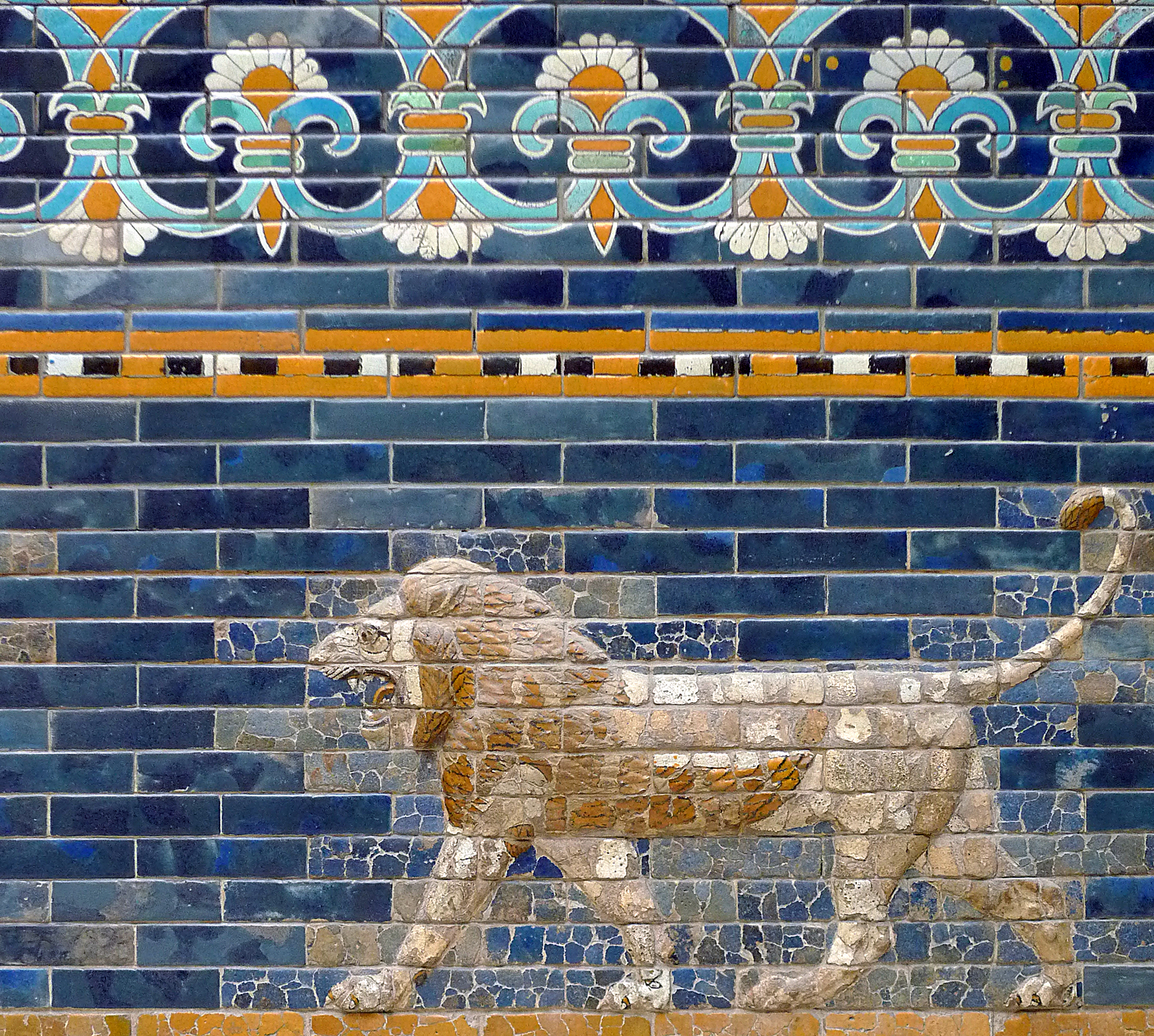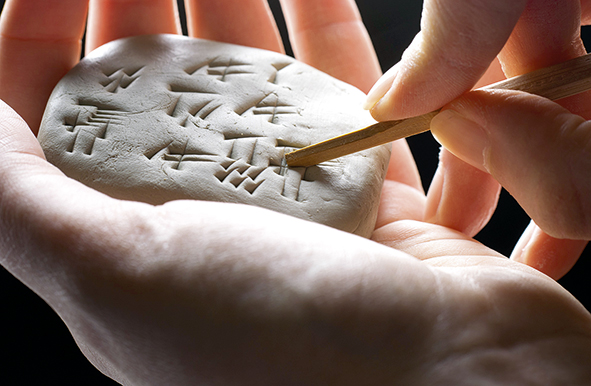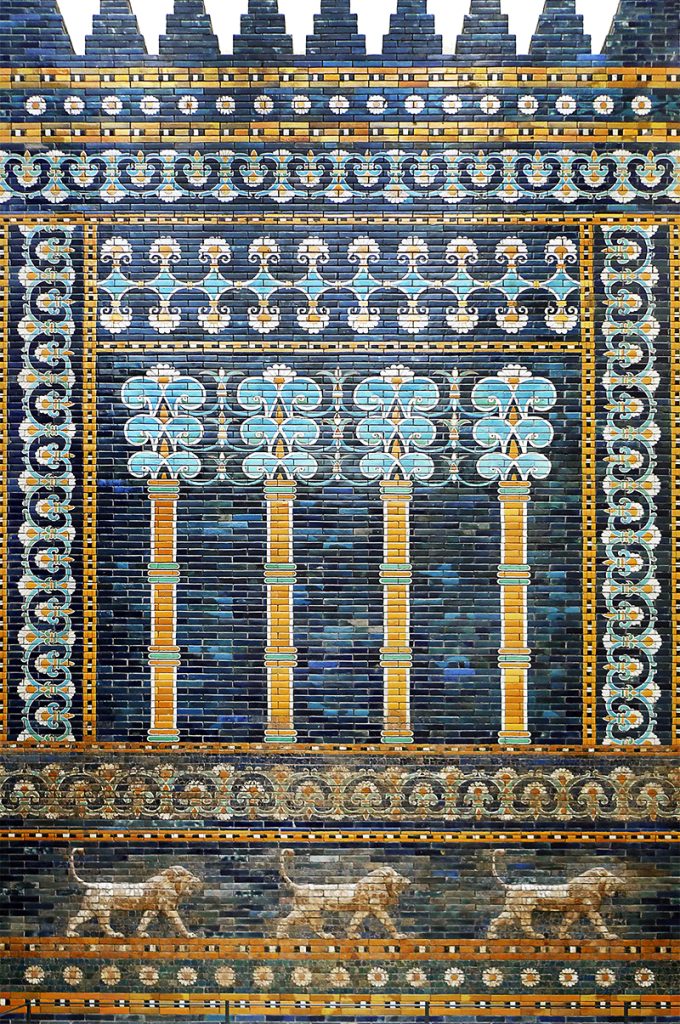
Bible, History, Archaeology
Bible,
History,
Archaeology
A cuneiform tablet
reveals the name of an important figure,
Nebo-Sarsekim
Contents:
The discovery – The translation – Historical background – TO FIND OUT MORE
 The discovery
The discovery
The cuneiform tablet (BM 114789) mentioning Nebo-Sarsekim was discovered in the 1870s in Sippar, an ancient Babylonian city located 32 km southwest of Baghdad and 57 km north of Babylon.
Image opposite: cuneiform writing takes its name from the strokes in wedge-shaped impressions made by a calamus on soft clay. From the Latin cuneus meaning «corner». D.R.
By the end of the 19th century, tens of thousands of cuneiform tablets had been recovered from the site and brought to the British Museum (Gasche and Janssen 1997).
It was only later, in 1920, that the Nebo-Sarsekim tablet, just 5.5 cm wide, was acquired by the British museum.

A detail of the Processional Way in the ancient city of Babylon, partially reconstructed in the Berlin Museum.
Above: one of the 120 lions depicted along the Processional Way. Geometric motifs and sacred trees accompany the procession of these lions. © Théo Truschel.
The translation
Since 1991, Michael Jursa, Associate Professor at the University of Vienna, has been sifting through the 130,000 or so tablets inscribed in the British Museum to unearth some data on Babylonian officials. On July 5, 2007, he deciphered the name Nebo-Sarsekim (Reynolds 2007) with its full title, the one mentioned in the book of Jeremiah 39:2-3. It also mentions the future king Nériglissar:
...in the eleventh year of Zedekiah, on the ninth day of the fourth month, the city was breached, - all the leaders of the king of Babylon came forward, and occupied the middle gate: Nergal-Sharezer, Samgar-Nebu, Sarsekim, head of the eunuchs, Nergal-Scharetser, chief of the magi, and all the other chiefs of the king of Babylon... Louis Segond version.
The proper nouns quoted are to be cut differently and understood as follows in the Babylonian language:
«Nergal-sarésér, Samgar» = Nergal-šaruşur, the simmagir » :
«Nebo, Sarsekim, great eunuch» = Nabu-šarussu-ukin, chief of the eunuchs » ;
«Nergal-sarésér, great magician» = «Nergal- šar-uşur, the rab mugi » ;
Translated from Jursa, 2008. British Museum, London.
 Image opposite: the cuneiform tablet bearing the name of Nabu-Šarussu-ukin, the chief eunuch (rab ša-rēšil), according to Jeremiah 39:2-3. It measures 5.5 cm wide.© D.R.
Image opposite: the cuneiform tablet bearing the name of Nabu-Šarussu-ukin, the chief eunuch (rab ša-rēšil), according to Jeremiah 39:2-3. It measures 5.5 cm wide.© D.R.
The title of simmagir refers to the governor of the province of the same name in Babylonia. This was the future king Neriglissar (560-556 B.C.). The title of rab-mugi applies to a Babylonian army corps command. It is a homonym of the first Nergal-šar-uşur.
The tablet is so well preserved that it can be read in its entirety and deciphered quickly (Alberge 2007). It is an ordinary receipt acknowledging payment by Nebo-Sarsekim of 750g of gold to the Esagil, a temple in Babylon. Unusually for this type of document, the precise date is mentioned: the tenth year of Nebuchadnezzar II (the Nebuchadnezzar of the Bible, 595 BC), eight years before the fall of Jerusalem and the destruction of its Temple. According to the biblical text, he was present at the siege of Jerusalem in 586/587 BC:
«1 ½ mine (750 g) of gold from Nabu-Šarussu-ukin, the Chief of the eunuchs (rab ša-rēšil), transmitted by Ardi-Banitu, the eunuch (ša-rēši) he had brought to Esagil: Ardi-Banitu, delivered it in Esagil.
In the presence of Bêl-usat, son of Aplaia, the bodyguard (naš patri), and Nadin, son of Marduk-zer-ibni. 18 Šabatu, year 10 of Nebuchadnezzar (II), king of Babylon (March 1, 594)».».
Translated from Jursa, 2008. British Museum, London.
Translated by F. Joannès after M. Jursa 2008.
The translation of the cuneiform text confirms his exact function and gives us Nabu-Šarussu-ukin's full name and title.
 Image opposite: the back of the throne room in Nebuchadnezzar II's palace in Babylon, partially reconstructed at the museum. in Berlin. © Theo Truschel.
Image opposite: the back of the throne room in Nebuchadnezzar II's palace in Babylon, partially reconstructed at the museum. in Berlin. © Theo Truschel.
Historical background
In the Scriptures and in the Chronicles It is reported that Nebuchadnezzar laid siege to Jerusalem (circa 589 B.C.). Zedekiah, who had been appointed tributary king of Judah by Nebuchadnezzar II, had revolted and made an alliance with Egypt, in the person of Pharaoh Hophra (called Vaphres by Manetho, Apries by Herodotus).
The siege was particularly violent (2 Kings 25, 3-8). When Nebuchadnezzar finally took over the city in 586/587 B.C., Zedekiah's sons were put to death in front of their father, who had his eyes gouged out and was taken into captivity in chains until his death.
The climax of the Babylonian campaign was the complete destruction of Solomon's Temple (the First Temple); Jerusalem was plundered and razed to the ground by Nebu-zar-adan, Nebuchadnezzar's captain of bodyguards, the population deported, the whole region depopulated except for a few vine-growers and farmers (Jérémie 52,14-16) :
«...He burned the house of the Lord, the king's house, and all the houses of Jerusalem; he delivered all the houses of any importance to the fire. All the army of the Chaldeans, which was with the chief of the guards, demolished all the walls forming the enclosure of Jerusalem. Nebu-zar-adan, chief of the guards, took captive some of the poorest of the people, those who had remained in the city, those who had surrendered to the king of Babylon, and the rest of the multitude...». Louis Segond version.
It is at this point in Scripture that the Ark of the Covenant in the Temple of Jerusalem disappears from history.
A proposal for a possible version of Solomon's Temple, known as the First Temple: the one with the covered vestibule. (I Kings 6-8 and II Chronicles 3-5). It was completely destroyed by Nebuchadnezzar's Neo-Babylonian army in 586-587 BC © Théo Truschel.

Find out more
Bertrand Lafond, Aline Tenu, Francis Joannès, Philippe Clancier.
Mesopotamia. From Guilgamesh to Artaban (3300-120 BC)
ANCIENT WORLDS under the direction of Joël Cornette.
Éditions Belin, 2017.

 The discovery
The discovery
 Image opposite: the back of the throne room in Nebuchadnezzar II's palace in Babylon, partially reconstructed at the museum.
Image opposite: the back of the throne room in Nebuchadnezzar II's palace in Babylon, partially reconstructed at the museum. 